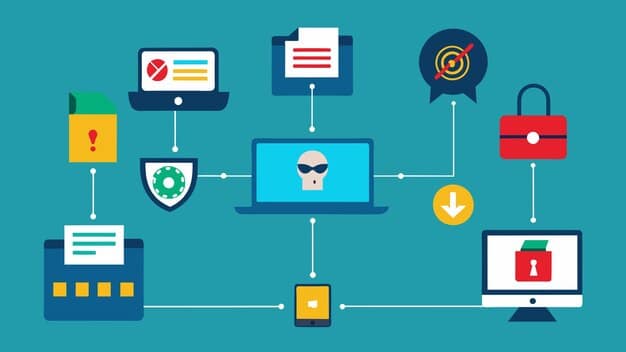Cybersecurity Mandates: Is Your State Ready for 2026?

Is Your State Ready? New Federal Mandates for Cybersecurity in K-12 Education by January 2026 represent a significant shift in how schools protect student data and digital infrastructure, requiring states to proactively address vulnerabilities and implement robust security measures to meet these impending requirements effectively.
As January 2026 approaches, a critical question looms for states across the US: Is Your State Ready? New Federal Mandates for Cybersecurity in K-12 Education by January 2026 are set to transform how schools safeguard their digital environments, and preparation is no longer optional.
Understanding the Urgency of K-12 Cybersecurity Mandates
The digital landscape of K-12 education has expanded dramatically, bringing with it increased cybersecurity risks. These new mandates aim to address these risks head-on, protecting vulnerable student data and ensuring the continuity of educational operations.
The Growing Threat Landscape
Schools are increasingly targeted by cyberattacks, ranging from ransomware to data breaches. These incidents can disrupt learning, compromise sensitive information, and incur significant financial costs.
The rise in remote learning and the increasing reliance on digital tools have only exacerbated these vulnerabilities, making robust cybersecurity measures more critical than ever.
Why Federal Mandates Are Necessary
The varying levels of cybersecurity preparedness across states and school districts have created a patchwork of vulnerabilities. Federal mandates provide a standardized framework to ensure all schools meet a minimum level of security.
These mandates are designed to protect students, educators, and the educational system as a whole from the ever-evolving threat landscape.
- Standardize cybersecurity practices across all states.
- Protect sensitive student data from breaches and misuse.
- Ensure continuity of educational operations in the face of cyberattacks.
- Provide a clear framework for schools to follow in implementing security measures.
In conclusion, understanding the urgency of these mandates involves recognizing the escalating threats and the necessity of a unified approach to safeguard K-12 education in the digital age.
Key Components of the New Federal Mandates
The new federal mandates encompass several crucial components designed to improve cybersecurity in K-12 education. Let’s break down these key elements to understand their implications.

Data Protection and Privacy
One of the primary focuses of the mandates is the protection of student data. Schools must implement measures to secure sensitive information, including personal details, academic records, and health information.
This includes complying with existing privacy laws and implementing practices to minimize data collection and retention.
Incident Response Planning
The mandates require schools to develop comprehensive incident response plans. These plans should outline procedures for identifying, containing, and recovering from cybersecurity incidents.
Regular testing and updating of these plans are essential to ensure their effectiveness.
Cybersecurity Awareness Training
Training for teachers and staff is another critical component of the mandates. Educators need to be aware of cybersecurity threats and how to prevent them.
- Regular cybersecurity training for all staff members.
- Simulated phishing exercises to test awareness and preparedness.
- Clear reporting procedures for suspected security incidents.
In conclusion, the key components of the new federal mandates highlight a multifaceted approach that stresses data protection, proactive planning, and continuous education to address the growing cybersecurity risks.
Assessing Your State’s Current Cybersecurity Posture
Before diving into compliance strategies, it’s crucial to assess your state’s current cybersecurity posture. Understanding where your state stands will help identify gaps and prioritize areas for improvement.
Evaluating Existing Security Measures
Start by evaluating the security measures currently in place at the state and local levels. This includes assessing existing policies, technologies, and training programs.
Consider conducting cybersecurity audits to identify vulnerabilities and areas of non-compliance.
Identifying Gaps and Weaknesses
Once you’ve assessed existing measures, identify any gaps or weaknesses. This could include outdated software, inadequate firewall protection, or a lack of cybersecurity awareness among staff.
Pay particular attention to areas where student data is most vulnerable, such as online learning platforms and data storage systems.
Benchmarking Against National Standards
Compare your state’s cybersecurity posture against national standards and best practices. This will help you understand where you stand relative to other states and identify areas where you need to catch up.
- Evaluate existing cybersecurity policies and technologies.
- Conduct cybersecurity audits to identify vulnerabilities.
- Compare state practices against national standards.
- Prioritize areas for improvement based on identified gaps.
In conclusion, a thorough assessment of your state’s current cybersecurity posture provides a critical foundation for developing effective compliance strategies and ensuring a safer digital learning environment for K-12 students.
Strategies for Achieving Compliance by 2026
Achieving compliance with the new federal mandates by 2026 requires a proactive and strategic approach. Here are some strategies to help your state meet these requirements.

Develop a Comprehensive Cybersecurity Plan
Create a comprehensive cybersecurity plan that outlines specific goals, objectives, and strategies for meeting the new mandates. This plan should be aligned with your state’s overall educational goals and priorities.
Invest in Cybersecurity Technologies
Invest in cybersecurity technologies that can help protect student data and critical systems. This could include firewalls, intrusion detection systems, and data encryption tools.
Ensure that these technologies are properly configured and maintained.
Implement Regular Training Programs
Implement regular training programs for teachers, staff, and students. These programs should cover topics such as phishing awareness, password security, and safe online practices.
- Create a cybersecurity plan aligned with educational goals.
- Invest in firewalls, encryption, and intrusion detection systems.
- Provide ongoing training to staff and students.
- Establish clear incident response protocols.
In conclusion, successful compliance by 2026 hinges on developing a robust cybersecurity plan, investing in essential technologies, and ensuring continuous education for all stakeholders.
Leveraging Federal Resources and Funding Opportunities
Navigating new federal mandates can be resource-intensive. Fortunately, there are several federal resources and funding opportunities available to support K-12 cybersecurity efforts.
Identifying Available Grants and Programs
Research and identify federal grants and programs that can help fund cybersecurity initiatives in your state. This could include grants from the Department of Education, the Department of Homeland Security, and other federal agencies.
Applying for Funding
Develop compelling grant proposals that clearly articulate your state’s cybersecurity needs and how the funding will be used to address them. Be sure to follow all application guidelines and deadlines.
Partnering with Federal Agencies
Partner with federal agencies to access technical assistance and expertise. This can help you develop and implement effective cybersecurity strategies.
- Explore grants from the Department of Education and Homeland Security.
- Create proposals that outline cybersecurity requirements clearly.
- Collaborate with federal entities to obtain knowledge.
In conclusion, leveraging federal resources and funding opportunities can significantly ease the financial burden of implementing new cybersecurity measures and strengthen your state’s overall preparedness.
The Role of Collaboration and Information Sharing
Collaboration and information sharing are crucial for enhancing cybersecurity in K-12 education. By working together, states can better protect against evolving threats.
Establishing a Cybersecurity Consortium
Consider establishing a cybersecurity consortium with other states to share information and best practices. This can help you stay ahead of emerging threats and develop more effective security strategies.
Sharing Threat Intelligence
Share threat intelligence with other states and federal agencies. This can help identify and mitigate potential threats before they impact your schools.
Engaging with the Cybersecurity Community
Engage with the broader cybersecurity community to learn from experts and stay informed about the latest trends and threats. This could include attending conferences, participating in online forums, and joining professional organizations.
- Form partnerships to facilitate knowledge sharing.
- Exchange data on threats among other countries.
- Participate in community platforms.
In conclusion, collaboration and information sharing among states, federal agencies, and the cybersecurity community are essential components of a robust cybersecurity strategy for K-12 education.
| Key Point | Brief Description |
|---|---|
| 🛡️ Mandate Urgency | Federal mandates require K-12 cybersecurity readiness by January 2026. |
| 🔑 Key Components | Data protection, incident response, and awareness training are essential. |
| 📊 State Assessment | Assess current measures to identify and address gaps. |
| 🤝 Collaboration | Collaboration and information ensure effective strategy |
Frequently Asked Questions
▼
The primary deadline is January 2026, by which states must have implemented the necessary cybersecurity measures. Interim milestones might exist depending on specific mandates.
▼
Responsibility typically falls on state education agencies and local school districts, with support from federal resources and cybersecurity experts.
▼
Training should cover phishing awareness, password security, data protection practices, and incident reporting procedures, tailored to the employee role and responsibility.
▼
Conduct a detailed cybersecurity audit, evaluate current security measures, and benchmark against national standards to identify gaps and prioritize improvements.
▼
Federal grants, technical assistance from agencies like the Department of Education, and partnerships with cybersecurity experts are great resources to get started.
Conclusion
As the January 2026 deadline approaches, it’s crucial for states to proactively prepare for the new federal cybersecurity mandates in K-12 education. By understanding the urgency, key components, and available resources, states can develop and implement effective strategies to protect student data and ensure a safe digital learning environment. Collaboration and continuous improvement will be essential in navigating this evolving landscape and safeguarding the future of education.





